#AsSeenInPrint: Message in the Sky
When did you first use a drone, and where are you now?
along the way. Is there anywhere that really stands out?
do you make these compositions look so perfect and crisp?
|\| ART BLOG HUMOR BLOG PHOTO BLOG CULTURE BLOG |:| FOR THE RENAISSANCE MAN & THE POLYMATH WOMAN |/|
#AsSeenInPrint: Message in the Sky
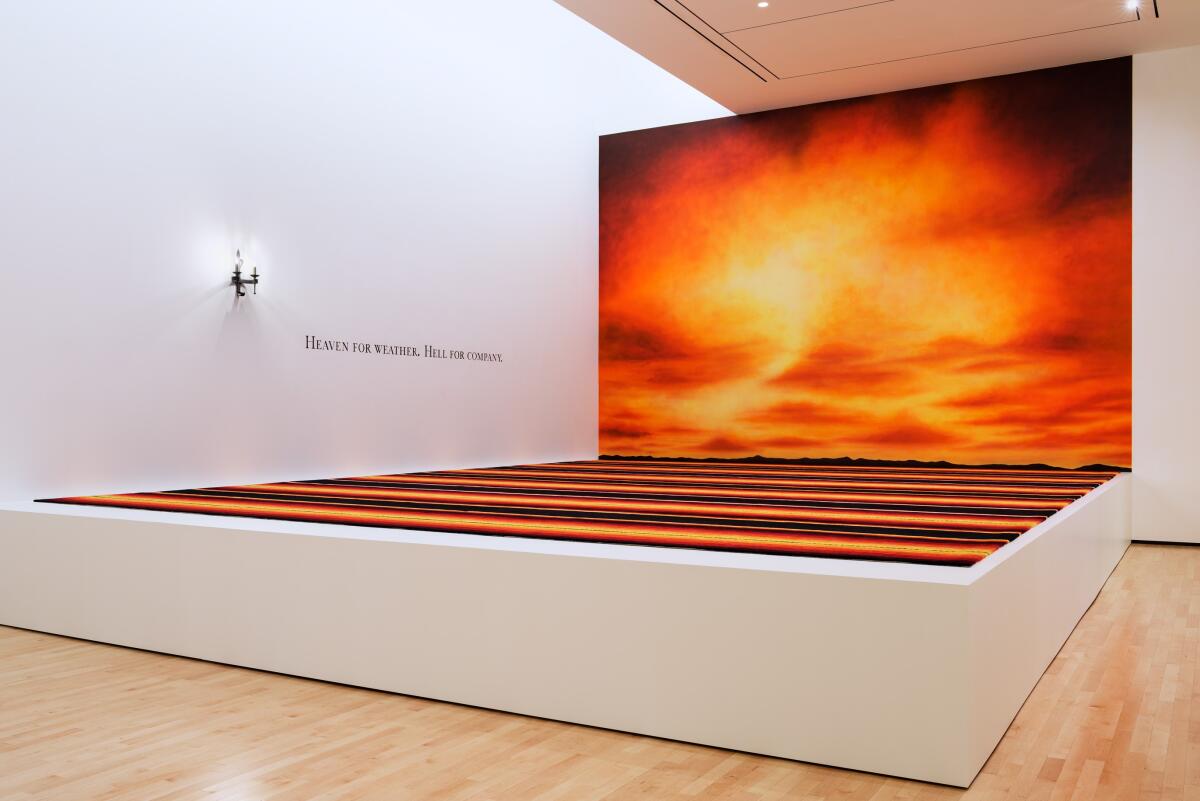
When Alexis Smith began to make art as the 1970s launched, two taboos apparently proved irresistible. Judging from the persuasive evidence in a marvelous, long-overdue retrospective of the Los Angeles artist’s exceptional career, she went straight for them.
One prohibition was against embedding literary qualities in art. Writing was writing, art was art, and never the twain should meet.
Tensions were running high between the inescapable incursions of messy mass media, pushing its way into every facet of modern life, and a worn formalist conviction that every artistic medium should be pure and vibrant unto itself. In this crabbed and narrow view of things, the prime offender was the Pop art typified by Andy Warhol, whose 1970 retrospective caused a hubbub at the organizing Pasadena Museum of Art.
The other restriction, not unrelated to the first, was a second-class status reserved for some artistic media. Painting and sculpture held firm at the top of the heap. Then there was the rest.
Somewhere below art’s pinnacle could be found ceramics, graphic art, weaving, photography, collage and more. Painters and sculptors had the capacity to be the great artists, the thinking went, while everybody else was irretrievably stuck being everybody else.
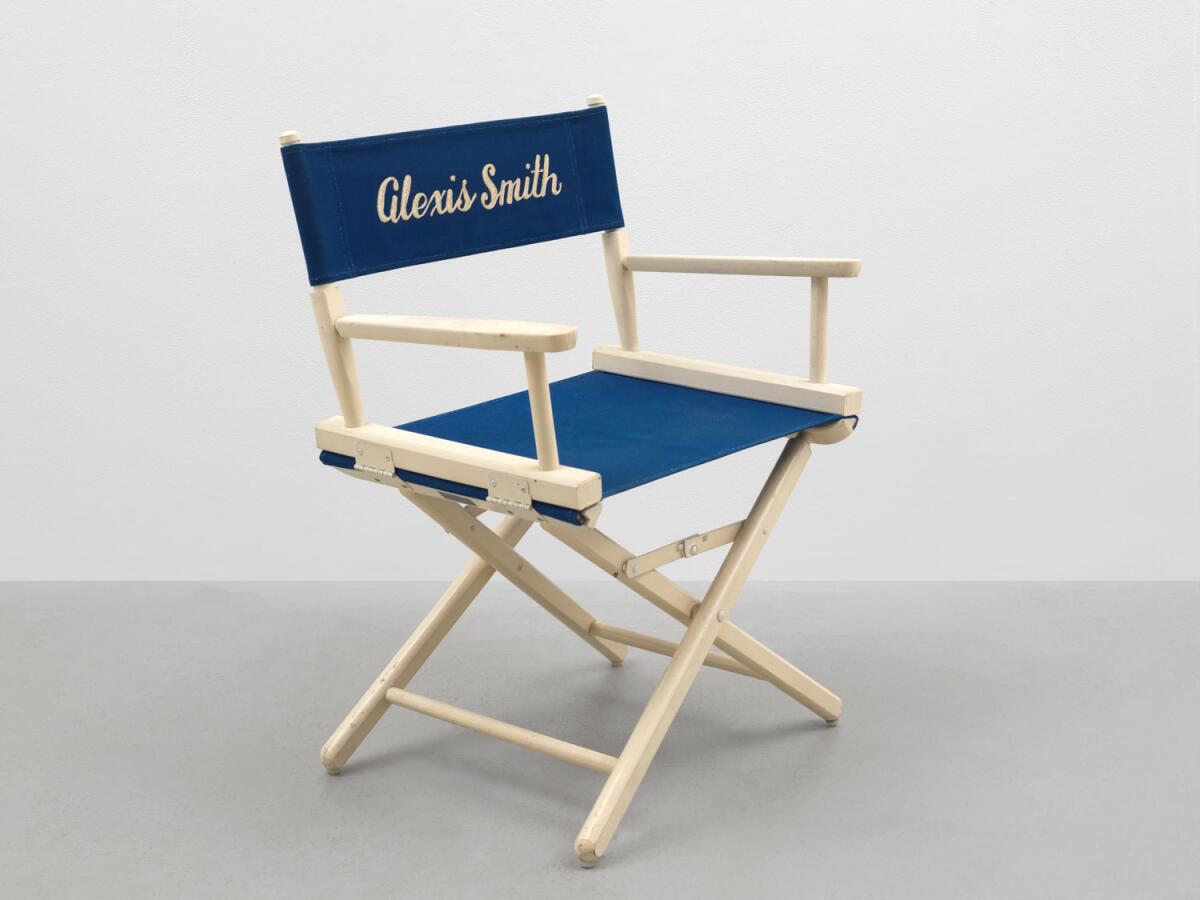
Smith, with a curious mind and an acute design skill, began to make literary collages — two taboos in one. Her wicked sense of humor helped ease a viewer into the maelstrom. Sheets of paper typed with excerpts from Jorge Luis Borges, John Dos Passos or Walt Whitman and punctuated with attached pictures, decals and objects were boxed in plexiglass, like disassembled books of cheeky poetry. Salvaged thrift-shop paintings, posters and photographs sporting collage elements and screen-printed text were set in elaborate picture frames, their design integral to the art rather than as a decorative support for it.
Finally, collages that were fully environmental began to spill across entire walls, fill whole rooms or even spread around outdoor sites in the landscape. Immersive installation in the early 1980s put the artist at the forefront of a major, now commonplace development in the art of the last four decades. Illness forced Smith, 73, to cease making work about six years ago, but the engrossing retrospective underscores her pivotal importance.
The stage is set in the earliest work among the 51 gathered for “Alexis Smith: The American Way,” deftly organized by curator Anthony Graham at the Museum of Contemporary Art San Diego, where the show is on view through Jan. 29. From 1971, the year after she graduated from art school at UC Irvine — Robert Irwin and Vija Celmins were two mentors — “Colorado” is an altered school yearbook held in a handmade wooden binder.
Shown on a pedestal, the book is open to a page displaying 56 anonymous head shots laid out in seven neat rows. The facing page, mostly blank, features a small, stenciled figure of a woman, arms and legs akimbo and repeated several times, as if falling through the empty sheet’s void.
Like that mystery woman in free fall, all those nameless, unidentified, neatly scrubbed and often goofy-looking graduates are about to be cast out into the unknown — just as Smith herself was as she left school. The work’s veiled autobiographical dimension is given a twist by the artist’s own name: Born Patti Anne Smith, she chose at age 17 to assume the moniker of an accomplished if not quite superstar Hollywood actor. Alexis Smith’s ultra-common last name classified her as a kind of Everywoman.

The show biz bona fides firmly located modern experience within the dizzying hall of mirrors that is the mass-media madhouse. Another 1971 collage, not in the show (but once owned by the actor), shows gritty determination: A clipped publicity still of the aspiring star is tucked in an envelope marked “Ma-chees-ma,” a feminized phonetic appropriation of the Spanish word for aggressive masculine pride.
The exhibition’s first gallery features a tantalizing face-off between a sculpture and a collage. Both are simply fabricated from commonplace objects.
The sculpture is an ordinary canvas folding chair, the stereotypical kind that directors or actors might find on a soundstage with their name emblazoned across the back in script. It’s a reserved perch from which the labor of creating art — and a public identity — takes shape.
On the wall opposite hangs a machine-printed “painting” of wild horses galloping in an unfettered stampede, kicking up a cloud of dust that captures light and bathes the Western scene in a golden glow. On it is affixed the famous album cover for the record “Set Free,” designed with a photograph of a crouching Patti Smith, the feral punk rocker with whom the artist happened to share a birth name and whose breakout song and album were titled “Horses.”
In works like these, Patti Alexis Smith — the artist, not the actor or the singer — creates cultural wormholes of uncanny effect. Her mordant social commentary is lodged between the glamorous fizz of Warhol and the tatty thrift store aesthetic of Mike Kelley. Slip-sliding collisions of image and text in works by artists like Edward Ruscha and John Baldessari provide a tart context.
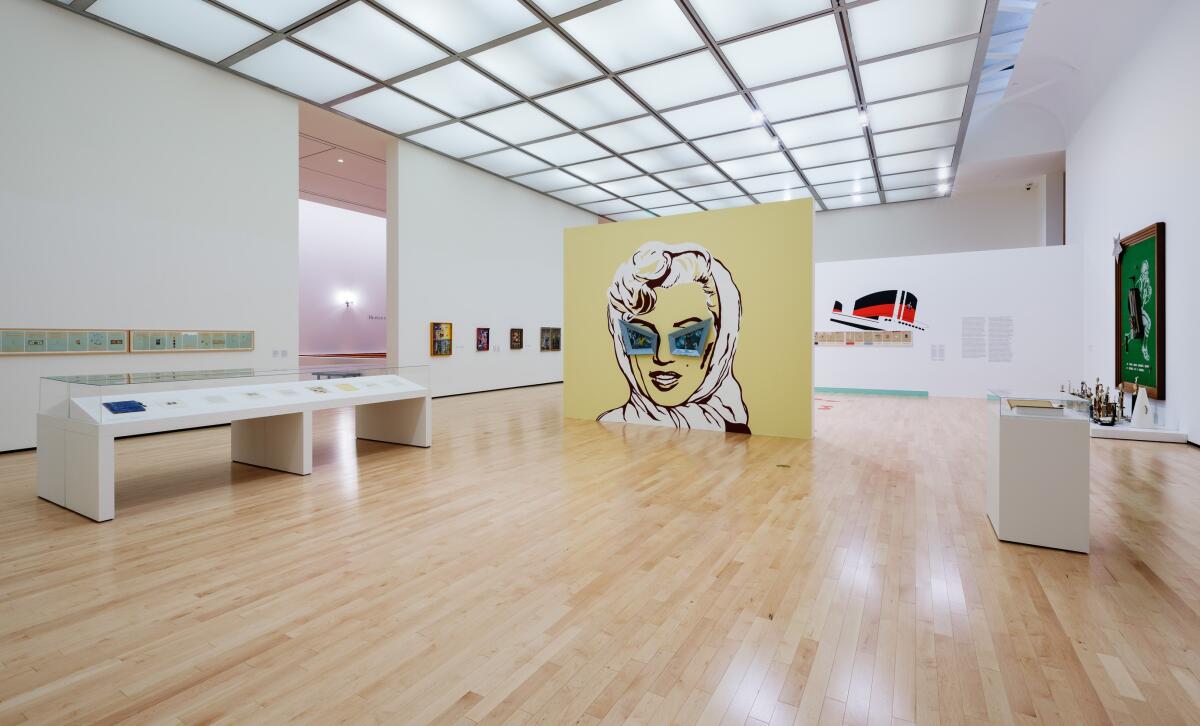
All these artists were keen on undoing the stifling prescriptions of modern art, high or low, entrenched within a mass media environment dependent on the choking proliferation of stereotypes and cliches. For Smith, second wave feminism of the 1960s and 1970s provided crucial fuel, with sexual politics a recurrent theme.
Those politics are almost always embedded within Smith’s sharp sense of absurdity, salted with the specter of eventual injury and loss.
The “Colorado” yearbook also includes a period cheesecake photograph that looks like the other Alexis Smith, her bullet-breasted two-piece bathing suit ambiguously greeted with the stenciled word “guffaw.” In a wall-size mural, “Isadora,” painted on cheap, disposable corrugated-cardboard, dancer Isadora Duncan’s liberated choreography leads to vanguard artistic celebrity and ultimate strangulation, the long scarf wrapped around her neck fatally caught in the axle of a car.

Car culture, as leaden an L.A. cliché as exists, turns up often. The two thematic collage-posters in “Blue Denim,” each advertising drive-in movies warning of the dangerous pleasures of teenage lust, are slyly linked together by a set of automotive jumper cables. Stand back, as electrocution competes with the spark of rebirth.
In “The 20th Century,” a B-movie poster is screen-printed with the legend, “I’ve died so often, made love so much — I’ve lost track of what’s real.” Haven’t we all?
The exhibition presents half a dozen trenchant installations, including “Red Carpet,” a 2001 commissioned work for New Mexico’s SITE Santa Fe. Taking the original location into account, the gaily serape-striped rug is patterned after a tourist souvenir, and it leads to a nearly abstract wall mural of flaming red-orange hues that signals either a glorious sunset or a wildfire’s deadly inferno. Stenciled onto the adjacent wall next to an incongruously glowing sconce is eternity’s conundrum: “Heaven for weather, hell for company.”
Unfortunately, one can no longer walk out and loll about on the Hollywood carpet, as was possible in Santa Fe. But La Jolla is a good place for the retrospective, because two monumental Smith masterpieces are permanently installed nearby at UC San Diego. They’re worth the short detour from the museum.
“Snake Path” is a 560-foot-long, 10-foot-wide outdoor footpath shaped like the biblical coiled serpent. It slithers its way uphill through an Edenic garden, dotted with apple and pomegranate trees, to the university library, repository of human knowledge. The snake’s flagstone surface is gently rounded, not flat, so care is needed on the climb. A quote from Milton’s “Paradise Lost” extolling self-reliance is encountered along the way, carved into a big, tombstone-like granite book. Think, the ensemble urges — and do so at your peril.
The 1992 installation was inspired by a monumental 1987 Smith mural, “Same Old Paradise,” a temporary commission she executed for the lobby at what is now the Brooklyn Museum. (The elaborate project was assisted by Meg Belichick, Rich Sedivy and Lucia Vinograd.) The magnificent painting, 22 feet high, 66 feet wide and featuring eight large-scale framed collages lined up along the lower right edge, was itself inspired by “On the Road,” Jack Kerouac’s counterculture novel of broken dreams and epic loss.
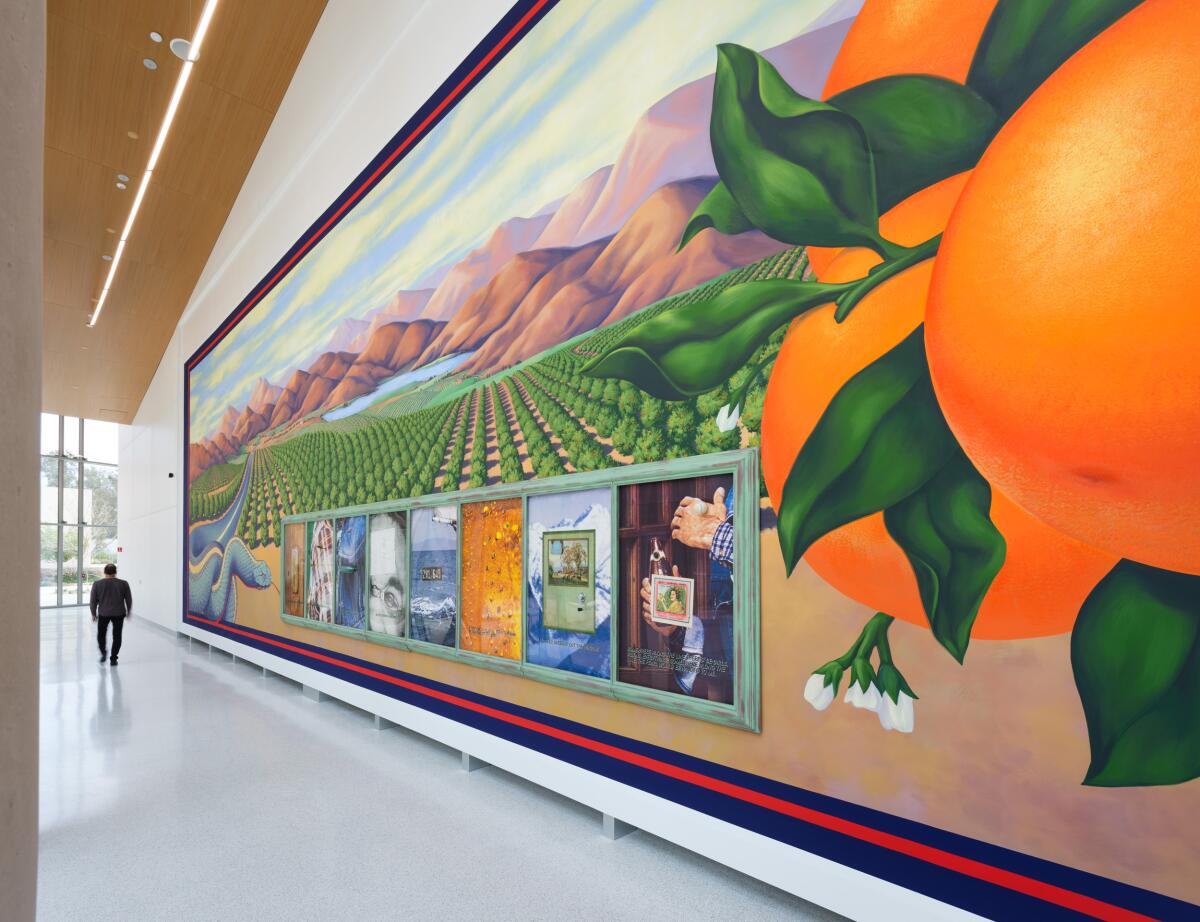
At the left, a two-lane blacktop highway morphs into an exquisite serpent, winding its way through verdant Eden — a gorgeously idealized California landscape worthy of a classic orange crate label. At the right, beneath an enormous trio of impossibly radiant oranges reminiscent of the lucky fruits that might come up in the windows of a Las Vegas slot machine, collages excerpt fragmented bits of Kerouac’s writing.
“Same Old Paradise” was shown in Los Angeles in 1992, a brilliant addendum to the traveling midcareer survey of the artist’s work from the Whitney Museum, which came to the Museum of Contemporary Art. After, Smith’s tour de force was rolled up and put in storage, where it languished for 30 years. Happily, its installation on an auditorium wall at UCSD’s new Sixth College campus was completed last year.
Like Smith’s namesake, her art exudes a period flavor. Rummaging through artifacts of the recent past, it is heavy on motifs from the 1940s and 1950s — a time just before and during the artist’s childhood, but also the tumultuous, transitional early years of modern American art’s emergence onto a world stage.
After World War II, as American art rose in prominence while a ruined Europe picked itself up and began to dust itself off, the formalist literary prohibition and the assertion of a hierarchy of mediums had taken hold. Smith, summoning bracing “ma-chees-ma,” made art that is a pungent corrective. The retrospective is an absorbing thrill.
‘Alexis Smith: The American Way’
Where: Museum of Contemporary Art San Diego, 700 Prospect St., La Jolla
When: Thursdays-Sundays, through Jan. 29
Cost: $15-$25; guests 25 and younger are free
Info: (858) 454-3541, www.mcasd.org
Los Angeles Times art critic Christopher Knight won the 2020 Pulitzer Prize for criticism (he was a finalist for the prize in 1991, 2001 and 2007). In 2020, he also received the Lifetime Achievement Award in Art Journalism from the Rabkin Foundation.
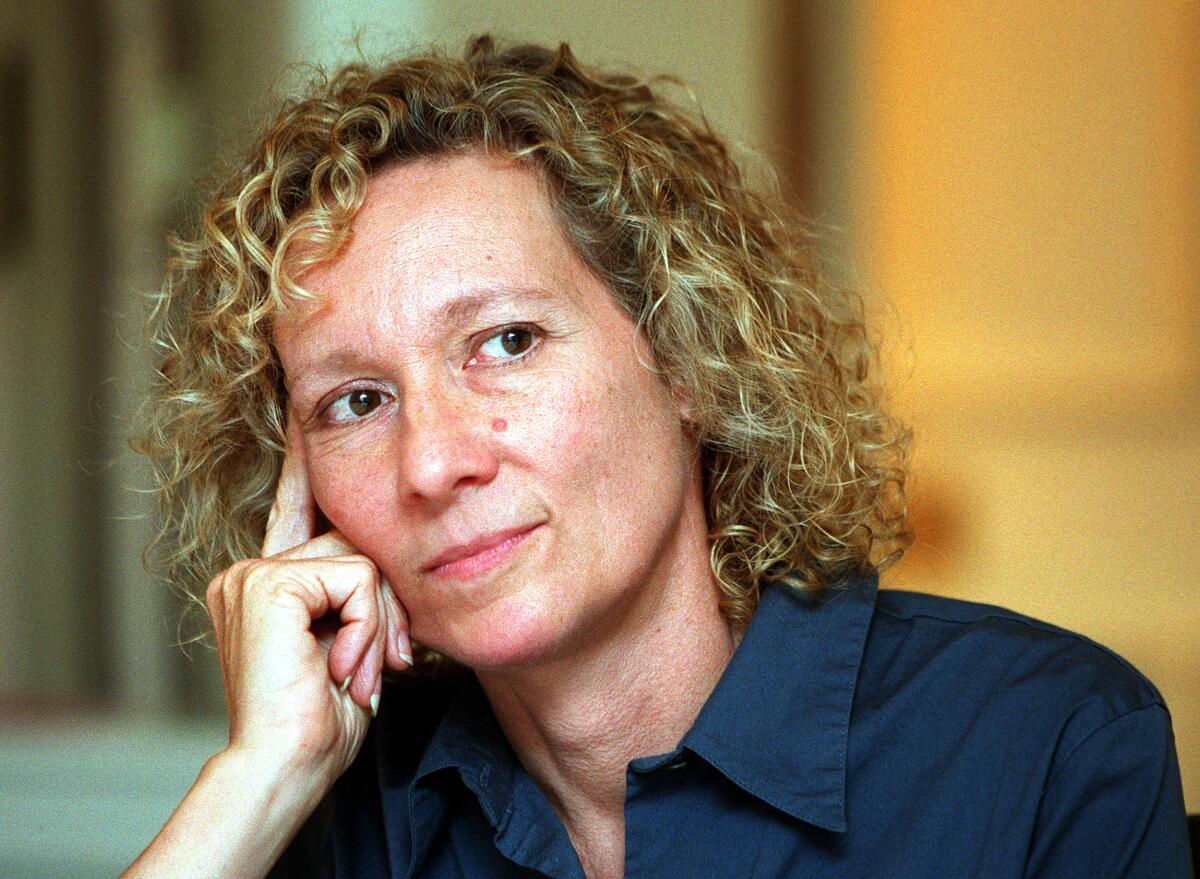
Alexis Smith, the clever, much-exhibited Southern California conceptual artist who winningly combined found images and smart phrases since the 1970s, died Tuesday morning at home in Los Angeles, according to her studio manager, Erin Calla Watson. She was 74 and had had Alzheimer’s disease since 2015.
Smith created art on both an intimate and a large scale, indoors and outdoors, in traditional and untraditional settings. Her imaginative collages and assemblages have drawn on, not just borrowed — and sometimes edited — quotations by everyone from Milton to Kerouac and Gershwin, and also her recycling of such unexpected raw material as silverware, pressed flowers, seashells and discarded brooms.
“Alexis Smith brought her signature wit to spot-on observations about Hollywood, society and politics,” said Stephanie Barron, longtime senior curator of modern art at the Los Angeles County Museum of Art. “Smith’s engaging collages stand alongside the work of her eminent Southern California peers — Ed Ruscha, John Baldessari, George Herms and Mike Kelley — as emblematic of her time and place.”
Since her first solo exhibition at Riko Mizuno’s L.A. gallery in 1974, Smith’s work has been exhibited in dozens of solo exhibitions in Los Angeles, New York, Miami and elsewhere. Her 1991 Whitney Museum of American Art retrospective in New York traveled to the Museum of Contemporary Art in Los Angeles in 1992. And the Museum of Contemporary Art San Diego initiated its own Smith retrospective in 2022, an exhibition that Times critic Christopher Knight called “an absorbing thrill.”
“I think the West helped me form a sense of self,” Smith told museum executive Richard Armstrong, author of the 1991 Whitney Museum catalog. “I have assimilated so much of its history from my father and his family: its traditional pioneer values of individuality, being who you want and changing your life and doing what you please.”
Brought up on the grounds of a mental institution where her psychiatrist father was assistant superintendent, Smith grew up accepting eccentricity in herself as well as in her surroundings. And when she chose to attend the University of California, Irvine, in the late 1960s, she did so when the place was so new there was no tenured faculty and few rules about what was and wasn’t art.
The fledgling UC Irvine campus — an incubator of such radical artists as Chris Burden and Barbara T. Smith (no relation), where instructors included such future art giants as Robert Irwin and Vija Celmins — helped shape the young Alexis Smith.
Choosing UC Irvine when she did “turned out to be one of the defining moments in my life,” she has said. “Irvine was brand new, with a fledgling art department that didn’t have many facilities or technical support. It was really just working artists coming in and talking with us. It was like sitting under a tree with Socrates.
“Before that, I thought art had to be rigorous oil painting and stuff like that. I learned from artists like Bob Irwin and Vija Celmins that it was much more, something that you could invent yourself. And even though it sort of had to fit into a framework of what had been done before, that framework in the ’60s was really loose. Art seemed interesting because you could invent something, and when it stopped filling your needs, you could invent something else.”
Smith reinvented herself as well, changing her name when she was in college. Her birth name was Patricia Anne Smith, or Patti Smith, which she didn’t much like. “I didn’t really feel like a Patti, and I kind of wanted to distance myself as much as I possibly could from my unhappy adolescence,” she once said. “I found out there was a movie star named Alexis Smith, and some funny photos of her I started using in my work. Then, just gradually, I became Alexis Smith.”
The two women later met, and artist Smith said actor Smith “was very nice about it. She bought one of my early works that had a picture of her in it.”
The artist also called herself at various times “a reliable girl reporter.” Interviewed at length in the book “State of the Arts: California Artists Talk About Their Work,” she referred to “basically a kismet style of working. I free-associate, have these ideas playing in my head and look for things that make sense with them.”
Los Angeles writer Hunter Drohojowska-Philp has called Smith a “culture scavenger,” and she started young. As a child, she would pick up junk at construction sites and make collages out of words she cut from magazines. Later, the floors and tabletops of her longtime Venice, Calif., studio were similarly replete with such things as magazine covers, discarded watches and plastic containers of sequins and seashells.
Her work often centered on California and particularly Hollywood, usually in the context of people reinventing themselves. “I think that Americans as a group have this kind of Westward Ho mythology that you just keep going further west to the next new place whenever you get tired of the old place,” Smith has said. “California is the furthest place west, and I think that the advent of Hollywood really crystallized that myth.
“The Hollywood of the mind is this place where any soda jerk can become Clark Gable, and high school girls suddenly become movie stars. You can become anything you want, which allows people who are not brilliant or incredibly industrious to still have something wonderful happen to them.”
Writing in the Whitney Museum’s 1991 catalog, her friend and sometime collaborator, poet Amy Gerstler, said, “Alexis Smith is necessary; her work essential. Luckily for us, she sprang into existence somehow. If she hadn’t, we would have had to invent her.”
Smith’s first public project was comprised of mixed-media collages on and around a wall-sized locomotive in a West Hollywood savings bank in 1982, while her later large-scale mixed-media installation “Taste” covers three walls of the Getty Center restaurant. Her public work also includes the 560-foot-long “Snake Path” at UC San Diego and the terrazzo floors of the Los Angeles Convention Center and of Ohio State University’s Schottenstein Center.
Once asked why she would take on large public art projects, she replied: “I think it’s a good balance in terms of my work. I do small collages that I can control for a kind of elite audience of artists and museum people. But my big public pieces are for people who don’t necessarily choose to have an art experience. People come upon them very unexpectedly and have to puzzle them out.”
Smith also emphasized the teaching element of her work, telling one museum audience, “What I try to do is put ideas into this visual form so you can take them out and they will be your ideas because they’re not written. When somebody writes something, they give you the ideas and you can accept them or reject them, but with something like this, you can extract what I put in or get ideas I didn’t put in.
“If you do your art form well, it is smarter than you are. I’m stuck in my own time, but the art itself is much more flexible. It can be part of a zeitgeist that I won’t be part of. I’ve already lived long enough to see that happen. I really enjoy doing what I do, and it gives my life meaning. It’s a thing I made up, and it has provided me with the opportunity to have an interesting life.”
Smith is survived by her husband, artist Scott Grieger.
Isenberg, a former Times staff writer, is the author of “State of the Arts: California Artists Talk About Their Work” (William Morrow, 2000).
The artist’s studio is part factory, part chapel, part Merlin’s cave, reliquary and museum. Some artists say it doesn’t matter where they make art. Others claim their studio is their art. Some cities preserve studios, but L.A. does not. We worship artists; we trade real estate.
Sunday is the 30th annual Venice Art Walk & Auctions, when artists open their studio doors for the public to peek at sanctum sanctorums in houses, lofts and commercial buildings. However, there is one less studio to visit -- lost to gentrification, a byproduct of the venerable walk. It was the work space and home of collage artist Alexis Smith.
At 17, Patti Anne Smith reinvented herself as Alexis, taking the name of a fading movie star. With this new identify, Smith became a living collage, a layering of her original self and a celebrity she’d never met.
In the 1970s, as minimalism collided with conceptualism, Smith studied with Vija Celmins and Robert Irwin at UC Irvine. Recycling discarded matchbooks, clippings, menus, playing cards, license plates, movie posters, swizzle sticks and bowling balls, Smith pioneered an approach to assemblage, making collages and installations that comment on the moral lapses and flimsy psychology of American culture. Aphorisms attached to her work are by the famous and infamous, from Walt Whitman and Charlie Chan to Richard Nixon and Prince. They are cryptic, witty and poignant.
Venice at the edge of the Pacific was founded as an amusement park in 1904. By the late ‘60s it was run down, cheap and dangerous, ideal for artists, hookers and drug dealers. In 1972, working for an architect named Frank Gehry, Smith moved into a storefront loft at 1907 Lincoln Blvd. The open room had a vibe. It had just been the workshop of techno-wizard Jake Brogan, then formulating prototypes for Gehry’s cardboard tables and chairs.
Smith became a star of a generation that includes L.A. artists Barbara Haskell, Chris Burden, Mike Kelly and Carole Caroompas. It took a lot of stuff to keep shining. She hoarded finds from thrift stores, back alley garbage bins, roadside diners, hotels, motels and restaurants. Everything came back to the loft where she lived and worked, cooking up her meals and her art. For three decades, Smith created work for shows on both coasts, including a retrospective at New York’s Whitney Museum of American Art.
Piles in the studio grew until thousands of doohickeys and whatnots were spread over tables, floors, sofas, the kitchen counter and the sleeping loft. The place became a complex collage, designed with a byzantine logic known only to the artist, who was raised by her father, a psychiatrist, on the grounds of a mental hospital in Norwalk.
In 2005, with no warning, Smith’s landlord served notice. He had sold 1907 Lincoln to a real estate firm. Smith had 30 days to vacate. All that she knew, all that she was making, lay on the floor and counters of a studio that was no longer hers.
Four weeks later, Smith turned in her keys, and the studio’s ordered chaos was shipped to garages and warehouses. After decades of gluing things together for galleries and museums, Smith’s life was unglued. What remains of her spiritual home is the made-on-a-Mac booklet created by her husband, L.A. artist and sage Scott Grieger, with digital images he took just days before the movers arrived.
Today, 1907 Lincoln still stands, its studio space gutted for offices. Smith is back with two simultaneous solo shows in L.A. What does she think about her loss? When called for comment, her machine answered: “There are the known knowns and the known unknowns. And then there are unknown unknowns, the things that we don’t know that we don’t know. A little Donald Rumsfeld brought to you courtesy of Alexis Smith. Leave a message.”
For Watters’ past columns, go to latimes.com/lostla.